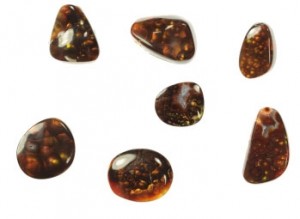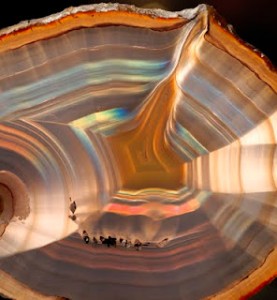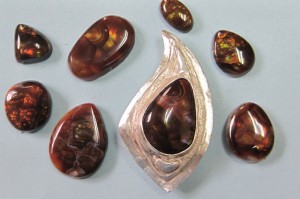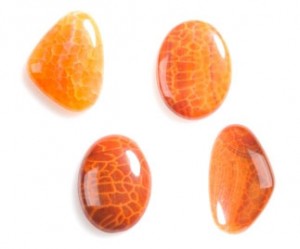- NEW DVD Series – Stone Setting with Bezels
- Tube Set Charm by Kim St. Jean
- Prong Basket Pendant by Kim St. Jean
- NEW DVD Series – Stone Setting with Cold Connections
- New DVD Series – Stone Setting with Wire
- NEW DVD Series: Introduction to Stone Setting by Kim St. Jean
- Featured Tool: Bracelet Bending Plier
- NEW Dvd by Eva Sherman
- Fun, Fast Fold Forming DVD Series
- Double Band Ear Cuff from Alex Simkin
Gem Profile May 11: Fire Agate and Iris Agate
by Rose Marion, Wire-Sculpture.com

Fire Agate and Iris Agate, one in a Series on Quartz
Shop Agate Cabochons | Shop Agate Beads | Shop Fire Agate Cabochons | Shop Crackle Fire Agate Cabochons
Fire Agate
Fire agate is a special kind of agate that appears brown from a distance. However, upon closer inspection, this agate is botryoidal in appearance (as I mentioned last week, that means it looks like a boiling pan of water caught bubbling, frozen in time – or like a bunch of grapes). What makes fire agate more interesting than typical botryoidal agate is its color play. Upon its brown background, a rainbow fire plays, with iridescent red, green, gold, and sometimes blue lighting up the surface of the stone. Fire agate received its name from the feeling of staring into the embers of a fire, resulting in a similar color play.
How did fire agate acquire its firey colors? It is thought that hot water, filled with colloidal silica and iron oxide and heated by volcanoes, raced into cavities in rock and then slowly cooled, forming a hard agate. Alternating layers of silica and iron oxide, forming over time, cause the schiller and iridescence. Fire agate is especially rare because unlike regular quartz, which is found all over the world, fire agate is only found in pockets of the southwestern US and northern Mexico. It’s estimated that fire agates are 24-36 million years old, due to the timing of volcanic activity in that region of the world.

Jane Elizabeth Duke brought this fire agate home from Wire-SCulpture and created a magnificent Argentium and Gold Filled cabochon frame for it, attaching a peridot stone and a fire agate bead to the orbit design. (click to view full-sized)
There are 3 factors that contribute to fire agate’s rarity and high cost to be used as a gem in jewelry: as I mentioned, it has a unique creation, and is only found in specific locations. The third factor is lapidary effort. The botryoidal agate must be carefully shaped, removing the outermost layer to perfectly reveal the best colors. Removing too much chalcedony from the top layer will ruin the iridescent effect, and too little will leave the surface dull. This is why, when you visit Tucson or other gem shows and see fire agate cabochons resting in a tub of water or polished in a case, most are not calibrated-cut, but freeform.

Wire-Sculpture has a small selection of beautiful freeform genuine fire agate cabochons (limited supply)
Despite the delicate process of finishing a fire agate stone, the stones themselves are very sturdy and durable. Although it has a strong resemblance to opal, fire agate does not share the danger of cracking or crazing. The layers will not flake off, nor will the stone lose its shine: like its quartz and agate siblings, fire agate has a Mohs hardness of 6.5-7, much tougher to scratch than window glass.
For an amazing gallery of fire agate pictures, click here!
Metaphysically speaking, Fire Agate is said to have a deep, calming energy bringing security and safety. It is also linked to the fire element, of course, bringing vigor and opening the root chakra. it is also said to aid in conquering addictions and harmful desires.
Crackle Fire Agate
There is another type of stone that is often called fire agate by vendors, which we call crackle fire agate. This “stone” is typically either glass or carnelian that has been heat treated to produce the lava-like lines in the stone. While also in demand, crackle fire agate is not its rare and pricey cousin, real fire agate. The crackle fire agate on Wire-Sculpture is real agate that has been dyed and heat treated to achieve the firey, crackle effect.
Iris Agate
Iris agate is another, lesser-known kind of iridescent agate. Iris agate is also called rainbow agate, although some vendors simply call any agate that is colorful, “rainbow agate,” even when it does not have the iridescent effect. When true iris agate is thinly sliced, it shows all the colors of the rainbow! The effect is more delicate than fire agate. This rainbow effect is the result of very tightly packed, very thin layers and banding, and can occur in colorless or pale chalcedony. It is also mostly found in North America, although some has been recorded in Argentina. Because it must be sliced so thinly, iris agate is fairly rare in jewelry. You can read a complete analysis of iris agate at this link.

Iris agate slice - image courtesy of Karen Brzys, Gitche Gumee Museum, Grand Marais, MI www.agatelady.com and www.agatelady.blogspot.com, used with permission.
Next week, I will cover some agate you have probably wire wrapped, or seen in person: moss agate and plume agate. Have you made wire jewelry with moss agate or plume agate (including Graveyard Point Plume Agate)? Send your agate pictures to tips@wire-sculpture.com, and they could be featured!
Resources
- AgateLady’s Iris Agate
- Crystal-Cure.com
- Mindat.org Fire Agate
- Mindat.org Iris Agate
- Minoscam.org Iris Agate
- Wirewrapjeweler.com Fire Agate
Gem Profile by Rose Marion
Click to Receive Daily Tips by Email





















DeLane
May 11, 2012 at 6:57 am
Rose,
Fire Agate has been my favorite stone for many years. I especially love the stones that have the turquoise, purple and the green colors. The turquoise is fairly rare, but is very, very showy when found. Unfortunately, most of the Fire Agate found with dealers is the plain brown with a ittle bit of gold or red coloring. But your referenced location really has some fine pieces.
Baxter Abel
December 7, 2016 at 6:41 pm
I had no idea that there were so many different types of agate. I really appreciate what you said about fire agate, it’s cool to know that fire agate was created by volcanic activity. I’ve heard that fire agate is quite rare and expensive too.